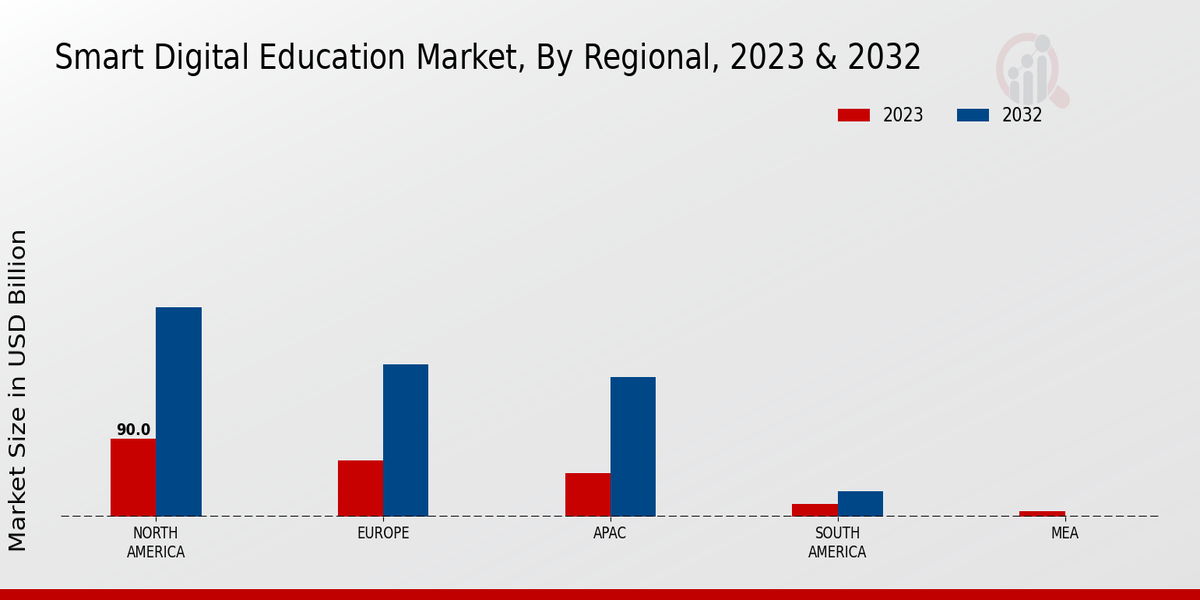Market Growth Projections
The Global Smart Digital Education Market Industry is projected to experience substantial growth in the coming years. With a market value of 158.9 USD Billion in 2024, it is anticipated to reach 937.5 USD Billion by 2035, reflecting a remarkable CAGR of 17.51% from 2025 to 2035. This growth trajectory indicates a robust demand for digital education solutions across various sectors, including K-12, higher education, and corporate training. The increasing adoption of technology in educational settings, coupled with the rising need for flexible learning options, is likely to drive this expansion. As the market evolves, stakeholders must adapt to emerging trends and technologies to remain competitive.
Focus on Lifelong Learning
The Global Smart Digital Education Market Industry is increasingly emphasizing lifelong learning as a response to the rapidly changing job market. As industries evolve, there is a growing need for individuals to continuously update their skills and knowledge. Digital education platforms are well-positioned to provide accessible and flexible learning opportunities for professionals seeking to enhance their competencies. This focus on lifelong learning is driving the demand for online courses and certifications, contributing to the market's expansion. With the projected growth from 158.9 USD Billion in 2024 to 937.5 USD Billion by 2035, the industry is likely to see a significant increase in offerings tailored to adult learners.
Globalization of Education
The Global Smart Digital Education Market Industry is significantly influenced by the globalization of education. As educational institutions expand their reach beyond national borders, they are increasingly adopting digital platforms to cater to a diverse student population. This globalization facilitates cross-border collaborations, allowing students to access international curricula and resources. The rise of global online learning communities fosters cultural exchange and enhances educational experiences. Consequently, the market is poised for growth as institutions leverage digital tools to attract international students and offer globally recognized qualifications, thereby enriching the educational landscape.
Technological Advancements
The Global Smart Digital Education Market Industry is experiencing rapid growth due to continuous technological advancements. Innovations such as artificial intelligence, machine learning, and virtual reality are transforming traditional educational methodologies. For instance, AI-driven personalized learning platforms enable tailored educational experiences, enhancing student engagement and retention. As of 2024, the market is valued at 158.9 USD Billion, indicating a robust demand for these technologies. The integration of immersive technologies, such as VR, allows students to engage in interactive learning environments, which can lead to improved educational outcomes. This trend is expected to accelerate as educational institutions increasingly adopt these technologies.
Government Initiatives and Funding
Government initiatives play a crucial role in the expansion of the Global Smart Digital Education Market Industry. Many countries are implementing policies that promote digital literacy and the integration of technology in education. For example, various governments are allocating funds to develop digital infrastructure in schools and universities, ensuring equitable access to educational resources. These initiatives not only enhance the learning experience but also prepare students for a technology-driven workforce. As governments recognize the importance of digital education, the market is likely to benefit from increased funding and support, further driving its growth in the coming years.
Increased Demand for Online Learning
The Global Smart Digital Education Market Industry is witnessing a surge in demand for online learning solutions. This trend is driven by the growing preference for flexible learning options among students and professionals alike. Online platforms provide access to a vast array of courses, enabling learners to acquire new skills at their convenience. The market's projected growth from 158.9 USD Billion in 2024 to an estimated 937.5 USD Billion by 2035, with a CAGR of 17.51% from 2025 to 2035, underscores the increasing reliance on digital education. Institutions are investing in robust online infrastructures to meet this demand, thereby enhancing their educational offerings.























